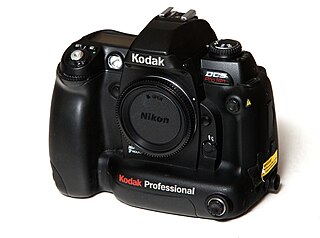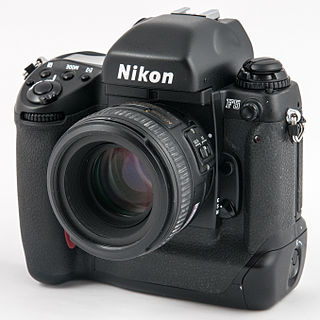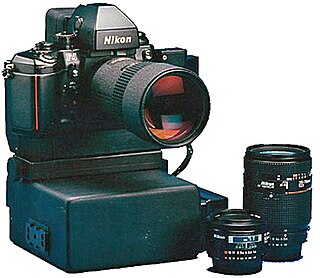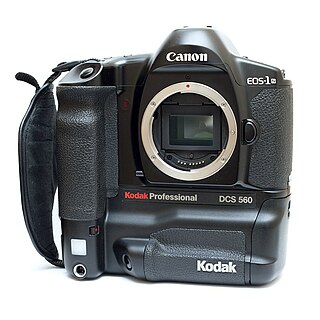
A CYYM filter is a color filter array. It has one cyan, two yellow, and one magenta element. [1] Developed by Kodak, it was used in the Kodak DCS 620x and DCS 720x DSLRs. [2] [3]

A CYYM filter is a color filter array. It has one cyan, two yellow, and one magenta element. [1] Developed by Kodak, it was used in the Kodak DCS 620x and DCS 720x DSLRs. [2] [3]
The Foveon X3 sensor is a digital camera image sensor designed by Foveon, Inc., and manufactured by Dongbu Electronics. It uses an array of photosites that consist of three vertically stacked photodiodes. Each of the three stacked photodiodes has a different spectral sensitivity, allowing it to respond differently to different wavelengths. The signals from the three photodiodes are then processed as additive color data that are transformed to a standard RGB color space.
C-41 is a chromogenic color print film developing process introduced by Kodak in 1972, superseding the C-22 process. C-41, also known as CN-16 by Fuji, CNK-4 by Konica, and AP-70 by AGFA, is the most popular film process in use, with most, if not all photofinishing labs devoting at least one machine to this development process.
The Kodak Professional DCS Pro SLR/n is a 13.5 megapixel full-frame 35mm digital SLR produced as a collaboration between Nikon Corporation and Eastman Kodak. It was an improved version of the Kodak Professional DCS Pro 14n series, and was based on a modified Nikon N80 film SLR and thus compatible with almost all Nikon F mount lenses. The camera was announced in early 2004 and became available to purchase mid-year. A monochrome variant named Kodak Professional DCS Pro SLR/n m of the camera existed as well.

The Kodak Professional DCS Pro SLR/c is a 13.5 megapixel digital SLR camera produced by Eastman Kodak. It is full frame—it uses an image sensor that is the full size of a 35 mm frame. It is compatible with Canon EOS lenses. The camera was launched on March 18, 2004, and incorporates the internal systems of the previous Nikon-compatible SLR/n in a Sigma SA9 SLR body.

The Kodak Professional DCS Pro 14n is a professional Nikon F80 based F-mount digital SLR produced by Eastman Kodak. It was announced at the photographic trade show photokina in Germany during September 2002; production examples became available in May 2003.

The Kodak DCS 300 series comprises two cameras, the DCS 315 and DCS 330. They are professional-level digital SLR cameras built by Eastman Kodak's Kodak Professional Imaging Solutions division. They were based on the Nikon Pronea 6i APS SLR camera and were aimed at a lower price point than other models in the Kodak DCS range. The 1.5 megapixel DCS 315 was launched in 1998, while the 3 megapixel DCS 330 was launched in 1999. The DCS 315 was the first digital SLR camera to incorporate an image preview LCD and inbuilt JPEG processing.
Bryce Edward Bayer was an American scientist who invented the Bayer filter pattern, which is used in most modern color digital cameras. He has been called "the maestro without whom photography as we know wouldn't have been the same."

The Kodak Professional Digital Camera System or DCS, later unofficially named DCS 100, was the first commercially available digital single-lens reflex (DSLR) camera. It was a customized camera back bearing the digital image sensor, mounted on a Nikon F3 body and released by Kodak in May 1991; the company had previously shown the camera at Photokina in 1990. Aimed at the photo journalism market in order to improve the speed with which photographs could be transmitted back to the studio or newsroom, the DCS had a resolution of 1.3 megapixels. The DCS 100 was publicly presented for the first time in Arles (France), at the Journées de l'Image Pro by Mr Ray H. DeMoulin, the worldwide President of the Eastman Kodak Company. 453 international journalists attended this presentation, which took place in the Palais des Congres of Arles.

The Canon EOS D30 is a discontinued 3.1-megapixel professional digital single lens reflex camera (DSLR) body, initially announced by Canon on May 17, 2000. It is part of the Canon EOS line of cameras and uses the EF lens mount. The EOS D30 was Canon's first "home grown" digital SLR. Before that point Canon had a contract with Kodak to rebrand the Kodak 2-megapixel DCS 520 as Canon EOS D2000 and the 6-megapixel DCS 560 as Canon EOS D6000 digital SLRs, which combined Kodak digital backs and Canon camera bodies.

The Kodak DCS 400 series was a series of Nikon based digital SLR cameras with sensor and added electronics produced by Eastman Kodak. It was part of Kodak's DCS line.

The Nikon F5 is a professional 35 mm film-based single-lens reflex camera body manufactured by Nikon from 1996 through 2004. It was the fifth in Nikon's professional film camera line, which began in 1959 with the Nikon F. It followed the Nikon F4 of 1988, which introduced in-body autofocus to Nikon's professional line. The F5 was in turn succeeded by the Nikon F6, as well as Nikon's parallel range of professional digital SLRs, beginning with the Nikon D1.

The EOS-1N is a 35mm single lens reflex (SLR) camera body produced by Canon. It was announced by Canon in 1994, and was the professional model in the range, superseding the original Canon EOS-1. The camera was itself superseded by the EOS-1V in 2000.

The Nikon F90 is a 35mm SLR camera manufactured between 1992 and 2001 and replaced the earlier Nikon F-801. At the time of its release it was noted for its fast autofocus speed compared to previous Nikon models, which had lagged behind competitor Canon's. It was thus seen by many as a 'stop-gap' measure to prevent the mass migration of many Nikon-using professional photographers to Canon, as Nikon's next fully professional camera, the F5, was some time away from release. The Nikon F4, the professional model available at the time of the F90's release, had very slow autofocus compared to Canon's autofocus SLRs.

The Canon EOS D2000 is a 2-megapixel digital single-lens reflex camera developed by Kodak on a Canon EOS-1N body. It was released in March 1998. It features a CCD sensor and can shoot at 3.5 frames per second. Many enthusiasts regard the D2000 as Canon's first truly usable Digital SLR. It was released in tandem with the Canon EOS D6000, a 6-megapixel model.

The Kodak Digital Camera System is a series of digital single-lens reflex cameras and digital camera backs that were released by Kodak in the 1990s and 2000s, and discontinued in 2005. They are all based on existing 35mm film SLRs from Nikon, Canon and Sigma. The range includes the original Kodak DCS, the first commercially available digital SLR.

The Canon EOS DCS 3 was Kodak's second Canon based Digital SLR camera released in July 1995, four months after Kodak EOS-DCS 5. It uses a modified Canon EOS-1N film camera with a modified Kodak NC2000e digital camera back attached. As a result, it maintained the Canon EF lens mount, and full compatibility with all of Canon's EF lenses made until that time. The camera was followed by the six megapixel Canon EOS DCS 1, which was released later in December 1995.
The Canon EOS DCS 1 was Kodak's third Canon-based Digital SLR camera. It was released in December 1995, following the cheaper EOS DCS 3, which was released earlier that year. Like that camera, it combined an EOS-1N body with a modified Kodak DCS 460 digital back. Despite offering a then-enormous resolution of 6 megapixels with a relatively large APS-H sensor, a number of technical issues meant that it was never a very popular camera other than for a few people with specialized roles.

The Nikon NASA F4 Electronic Still Camera is one of the first and rarest fully digital cameras with development started in 1987. While Nikon delivered a modified Nikon F4 body, most of the electronics for the digital camera and housings were designed and manufactured by NASA at the Johnson Space Center and other suppliers. It was first flown in September 1991 on board the Space Shuttle Discovery, mission STS-48. Later the cameras were flown on several other Shuttle missions including STS-44, 45, 42, 49, 53, 56 and 61.

The Canon EOS D6000 was Kodak's Canon-based digital SLR camera that was released in 1998.
The Canon EOS DCS 5 was Kodak's first Canon-based Digital SLR camera. It was released in March 1995. It combined an EOS-1N body with a modified Kodak digital back. The sensor had a size of 13.8 mm x 9.2 mm, which gives a factor of 2.6.